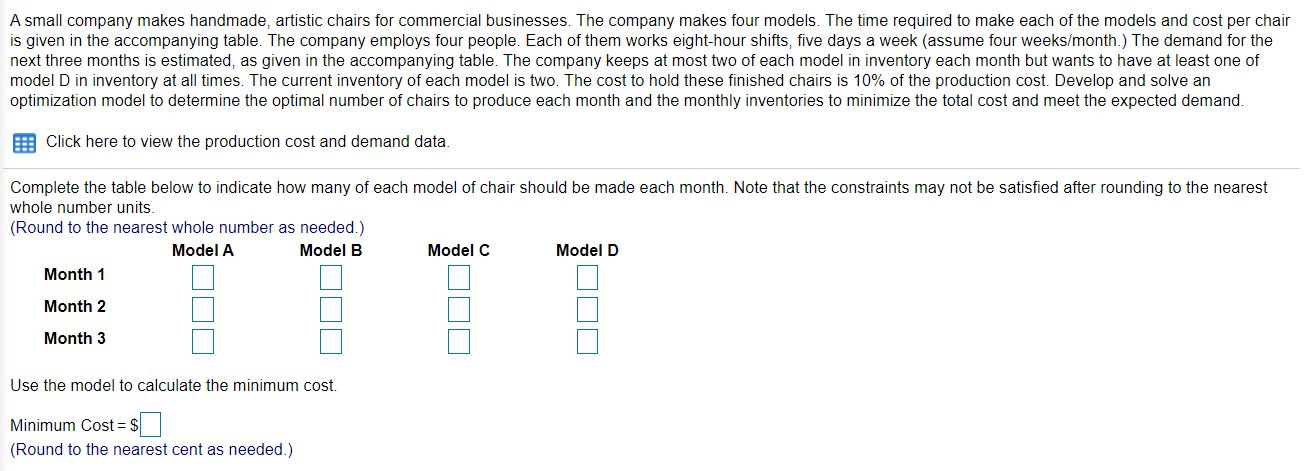Please solve using excel solver. The data is complete.

Cost and Demand Data
| | Model A | Model B | Model C | Model D |
| Cost per Unit | 890 | 660 | 500 | 760 |
| Hours Required per Unit | 40 | 22 | 12 | 34 |
| Demand (Units) | | | | |
| Month 1 | 7 | 4 | 4 | 9 |
| Month 2 | 7 | 4 | 5 | 4 |
| Month 3 | 6 | 8 | 8 | 6 |
A small company makes handmade, artistic chairs for commercial businesses. The company makes four models. The time required to make each of the models and cost per chair is given in the accompanying table. The company employs four people. Each of them works eight-hour shifts, five days a week (assume four weeks/month.) The demand for the next three months is estimated, as given in the accompanying table. The company keeps at most two of each model in inventory each month but wants to have at least one of model D in inventory at all times. The current inventory of each model is two. The cost to hold these finished chairs is 10% of the production cost. Develop and solve an optimization model to determine the optimal number of chairs to produce each month and the monthly inventories to minimize the total cost and meet the expected demand. Click here to view the production cost and demand data. Complete the table below to indicate how many of each model of chair should be made each month. Note that the constraints may not be satisfied after rounding to the nearest whole number units. (Round to the nearest whole number as needed.) Model A Model B Model C Model D Month 1 Month 2 Month 3 Use the model to calculate the minimum cost. Minimum Cost = $ (Round to the nearest cent as needed.) A small company makes handmade, artistic chairs for commercial businesses. The company makes four models. The time required to make each of the models and cost per chair is given in the accompanying table. The company employs four people. Each of them works eight-hour shifts, five days a week (assume four weeks/month.) The demand for the next three months is estimated, as given in the accompanying table. The company keeps at most two of each model in inventory each month but wants to have at least one of model D in inventory at all times. The current inventory of each model is two. The cost to hold these finished chairs is 10% of the production cost. Develop and solve an optimization model to determine the optimal number of chairs to produce each month and the monthly inventories to minimize the total cost and meet the expected demand. Click here to view the production cost and demand data. Complete the table below to indicate how many of each model of chair should be made each month. Note that the constraints may not be satisfied after rounding to the nearest whole number units. (Round to the nearest whole number as needed.) Model A Model B Model C Model D Month 1 Month 2 Month 3 Use the model to calculate the minimum cost. Minimum Cost = $ (Round to the nearest cent as needed.)







